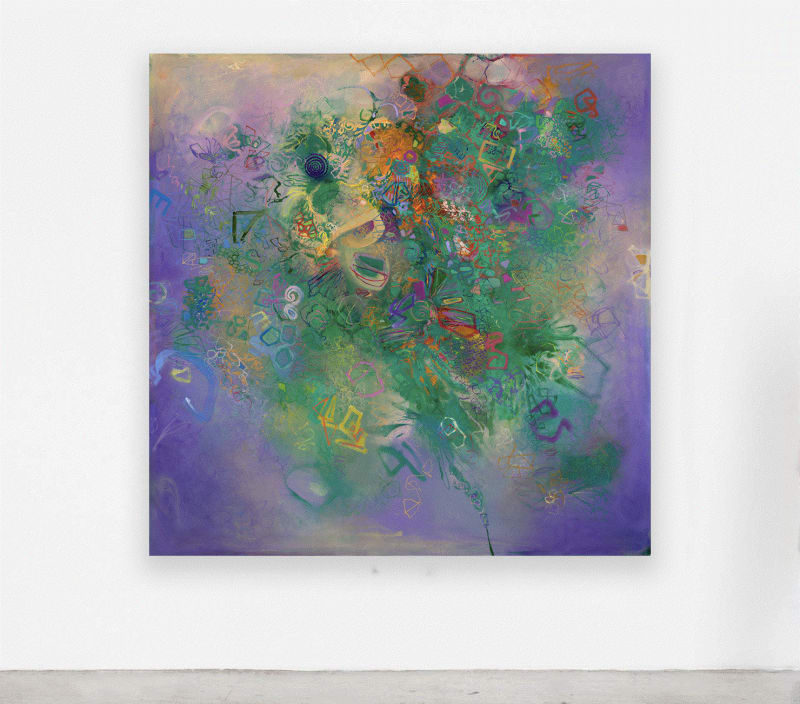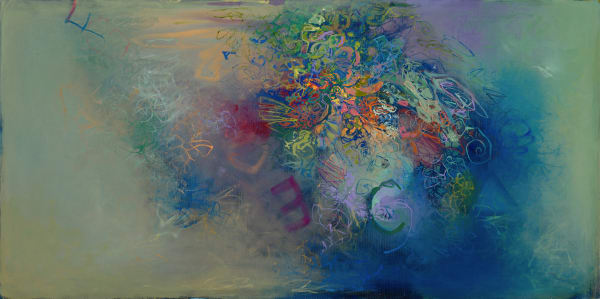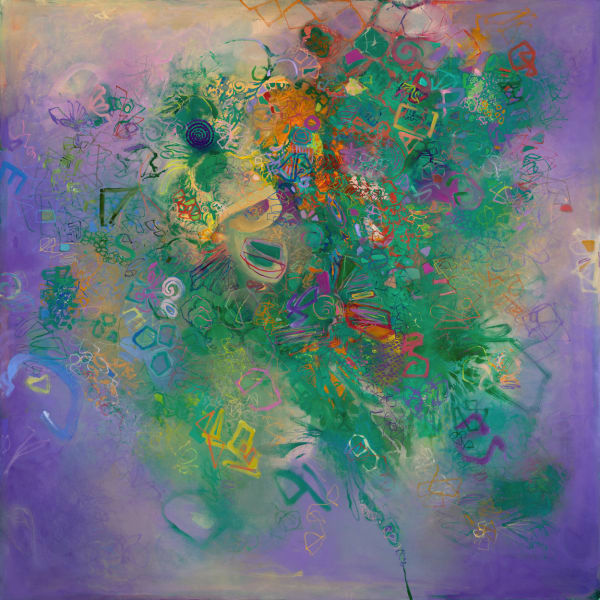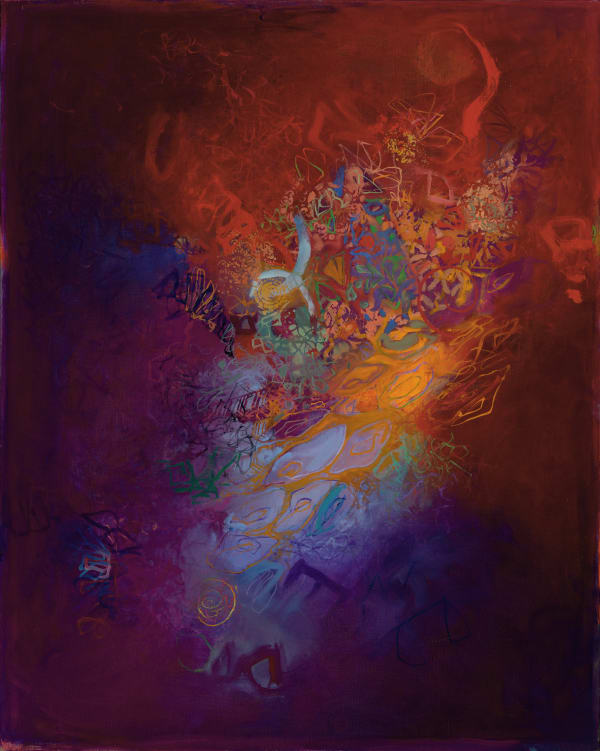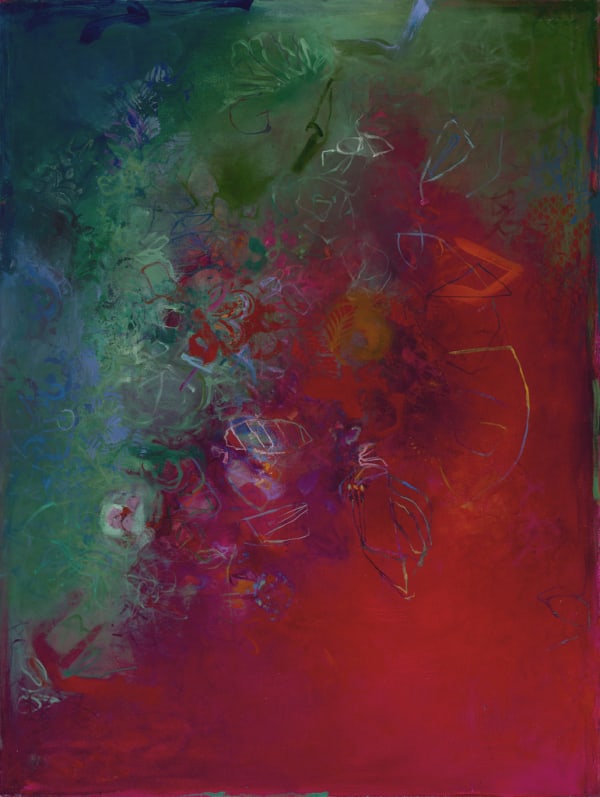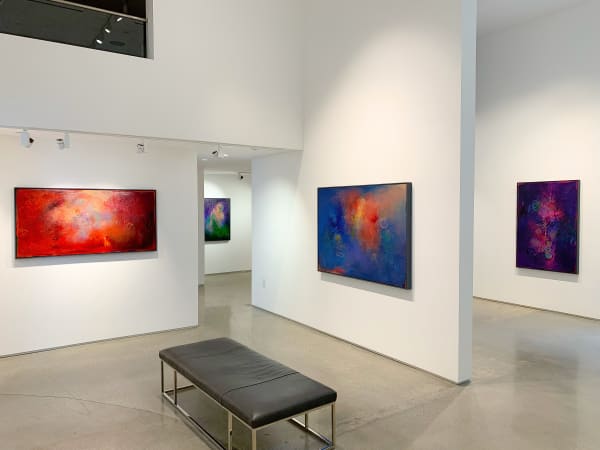Sigrid Burton
The ineffable aspects of the sublime and the transcendental power of painting are the foundation of Sigrid Burton’s practice. Burton believes painting concerns an interactive visual colloquy, providing a view to an interior dialogue and an immersive experience beyond the quotidian, much like a symphony engages the ear. The artist embeds gestural abstractions of organic forms in chromatic atmospheric grounds, reflecting on ideas of space and depth, employing idiosyncratic mark making and the resonant use of color.
The daily experience of color, light and atmospheric phenomena is ephemeral. Burton’s intention is to make light and depth tangible and visible on a 2-dimensional picture plane, capturing the phenomenological occurrence of reflection and refraction of light. In particular, in water, sky and deep space, not in a literal sense, but drawing from the history of these concerns in works by artists such as Turner, Monet, Rothko. Color creates this atmosphere and elicits not only an emotional, but also a physiological response. In addition, since 1990, Burton has been engaged in an investigation of Indian art forms and aesthetic theory, including academic scholarship and extensive travel in the subcontinent. India has an ancient and sophisticated aesthetic theory which holds, broadly stated, that the importance of a work of art is the response that the work evokes from the viewer. Within this context, color is understood to have great expressive and communicative power. For the artist, color is sui generis; it communicates in its own unique language.
Burton’s drawing and mark marking derive from the natural world, and refer to botanical and biological anatomies, including marine life, as well as, the structures of both macro and micro cosmologies, constellation diagrams, and alphabetic systems. The specific content is intended to be ambiguous, yet evocative, referencing light and spatial phenomena, a common language of forms, and a shared cross-cultural use of symbols.
The Carnegie Observatories based near the artist’s home and studio in Pasadena has had a particular impact on her work. Burton has attended lectures on developments in astronomy and astrophysics and visited observatories, including Las Campanas in Chile. These opportunities, including, her exposure to the extraordinary visual imagery currently being generated from observations in deep space, have allowed Burton to expand her thinking about the exciting interrelations of micro and macrocosmic configurations - the unifying structures and forms of the world around us and beyond.
Sigrid Burton (b. 1951, Pasadena, CA) received her B.A from Bennington College, Bennington, VM, in 1973, and her M.A from Columbia University, New York, NY, in 1999. Burton’s work has been featured in solo and group exhibitions across the United States including the Rockefeller Arts Center (2001); the Carnegie Art Museum (2018); the Brand Gallery and Art Center (2017); and the John and Mable Ringling Museum (1988). Her work is in the permanent collections of institutions including the Metropolitan Museum of Art (New York, NY); the Palm Springs Desert Museum (Palm Springs, CA); and the John and Marble Ringling Museum of Art (Sarasota, FL).
-

Holiday Show 2023
14 October - 23 December 2023Tufenkian Fine Arts is pleased to announce, Holiday Show 2023 , the gallery’s annual group show celebrating our gallery artists. To end the year, we have chosen a diverse selection...Lees meer -

Making Light Visible
Sigrid Burton 6 September - 29 October 2022Tufenkian Fine Arts is pleased to present, Sigrid Burton: Making Light Visible , an exhibition of paintings and works on paper by Los Angeles-based painter Sigrid Burton. This will be...Lees meer -

Holiday Show 2021
1 - 23 December 2021Tufenkian Fine Arts is excited to announce, Holiday Show 2021, a group show celebrating the artists who were featured in our exhibitions throughout the year. We are ending the year...Lees meer -

Multifaceted
Exploring the Bandwidth 16 October - 20 November 2021Tufenkian Fine Arts is pleased to present, Multifaceted , a two-part show featuring artworks by twelve contemporary artists co-curated between John David O’Brien and Caroline Tufenkian in the downstairs gallery...Lees meer -

Sigrid Burton
25 February - 25 April 2020Tufenkian Fine Arts is honored to present, Sigrid Burton, a solo exhibition of recent paintings by the Los Angeles based artist. This extraordinary show will kick off with an opening...Lees meer

